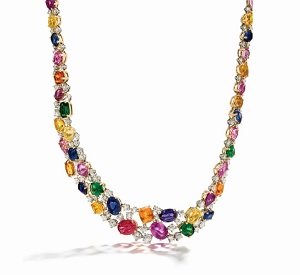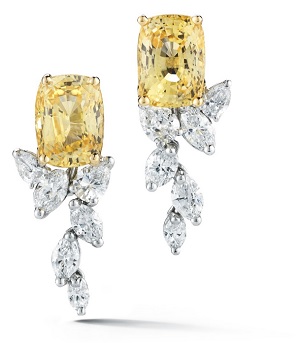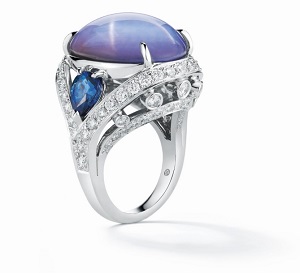 Heyman:
Heyman: The higher-end in the U.S. is still reasonably strong. It’s a challenging market as the luxury consumer has many options to spend their money, whether it be vacations, cars, boats, airplanes or jewelry. There are a lot of people going after the top 1 percent to 3 percent high-income customer.
We try to differentiate ourselves by getting as close as possible to the consumer through our retail partners. The customer is not just buying a piece of jewelry, they’re buying a relationship, a story and an emotion. It has to be the whole package.
Rapaport News: How do you develop that relationship with consumers as a wholesaler?Heyman: It is part of our branding strategy and it’s also how we work with the stores. A customer can buy a 20-carat sapphire in lots of places, but he can only buy a 20-carat Oscar Heyman sapphire in certain stores. With us, they’re buying more than just the commodity of a sapphire. We put together beautiful jewelry showcasing gems in such a way that whoever owns them won’t want to cash them in, even after decades of owning them. Their heirs will argue over who gets to keep them rather than liquidate because the jewelry is timeless and has lasting value.
Rapaport News: Given that brand value plays such a key role, how do you maintain its relevance and enhance its pull-factor?Heyman: Retailers display our pieces in their store as Oscar Heyman jewelry. We do advertising in cooperation with our retail partners and we do some national advertising on print, digital and social media platforms to support our brand. We feel our brand has a terrific story to tell given our ability to develop very high quality jewelry that’s been tested over time.
Rapaport News: How does the company ensure it sources the 'right' goods to support that reputation?Heyman: We tend to de-emphasize the metal in our jewelry. We want to source the finest quality of gemstones. We think of it as treasure hunting. Our buyers travel the world searching for treasures. We go to Sri Lanka, Bangkok, Hong Kong, Jaipur, as well as the major jewelry shows, looking for pieces that are good enough for us. We’ll look at hundreds of stones before we buy. We’re very picky.
Rapaport News: How do you work with retailers to ensure they have the jewelry that their customers want?Heyman: Our sales people maintain a close relationship with retailers by constantly keeping in touch with them, giving them the support they need. We aim to be their best, easiest supplier in our niche and have a long-term relationship with them. I’m third generation in our company and there are retailers who I work with that are third generation in their store. It’s a 50 year relationship that’s pretty special for us.

Rapaport News: How important are trade shows for your business?Heyman: At the shows, we want to continue to service and build relationships with existing customers, and reconnect with people who we know and have the potential to become our customer. And then there are introductions to people we don’t know, which is probably the most important aspect of a show.
Selling is only a component. At Las Vegas, we had about the same sales as last year and we were happy with it. But, sales at a show today are less than what they were 15 years ago. Buyers are not building up inventory the way they used to. A problem in our industry is that retail stores are relying more on memo. Stores we work closely with need to own some of the pieces. We won’t work purely on memo.
Rapaport News: How do auctions at Sotheby’s or Christie’s influence the market and buying trends?Heyman: I don’t think it affects the average retail store and we don’t look at auctions for trends. We rely more on our conversations with the retail sales people. We’re more interested in what the retailer on the front line is saying their customers are asking for.
And I’m not sure if I see a trend other than a steadily rising interest for unique, interesting pieces. Other than that, I haven’t seen a clear trend for 10 years already. We’ve shifted our focus a little to a slightly higher price point, targeting the top 2 percent or 3 percent of a store’s clients rather than say the top 25 percent.
Rapaport News: Is that a reflection of the current economic environment?Heyman: I think so. The middle class has stagnated a bit, which is a problem for our industry. I think the industry needs a wider base as the base is shrinking.
Rapaport News: Is that weakness in the middle income consumer particularly evident given that we’re in a U.S. election cycle?Heyman: Historically, election years have tended to be unsettling and not entirely conducive to high discretionary spending on luxury items such as jewelry.
Rapaport News: What are your biggest concerns about the market?Heyman: I think synthetic diamonds are going to have a big impact but I haven't yet figured out how. It’s an issue that’s looming and I’m personally watching it closely. Also, retail stores need to continue to educate millennials about the lasting value of fine jewelry. If they won’t buy jewelry, then what are we all doing here?
 Rapaport News: Have selling techniques changed with today's consumer?Heyman:
Rapaport News: Have selling techniques changed with today's consumer?Heyman: We try to sell more than just a piece of jewelry. For example, we have a very good store that brings their best customers to our office in New York - so they not only buy a piece of jewelry, they’re also involved in the process. They see our factory and they can talk to our designers or stone buyers. They take a whole and unique experience that can be shared with friends and family.
We also do a lot of custom design where there’s a back-and-forth between the customer, the retailer and us to produce a piece that the client wants. It can take time but in the end they not only have a piece of jewelry, they have a story to go with it. I think that’s important to today’s consumer.
Rapaport News: How do you see this year playing out for the industry?Heyman: This year will be fine. People will still have birthdays and anniversaries and other good events in life they want to celebrate. It’s important to remember that the jewelry industry is all about beautiful things that help people celebrate, cherish and remember life events and occasions. I don’t think that’s going to stop.
But the industry has to work hard to maintain its role in those life events. We have to be creative and think of interesting ways to expose the public to jewelry they want to buy and educate them to understand the value and beauty of the product.
* Pictures courtesy Oscar Heyman.